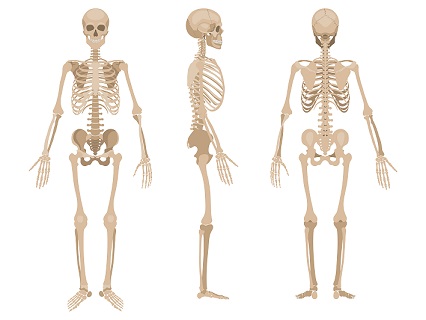The human body has 206 bones, and all of these are able to break. Any break of a bones, whether that be a tiny fracture, chip or the bone completely shattering, it is called a bone fracture. Here are some of the most common bones to become injured.
Skull (Cranium)
Injuries to the skull will usually be things like a skull fracture. It is relatively common and would occur as a result of a head injury.
Spine (Vertebrae)
The spine is made up of 33 vertebrae. 7 in the cervical region, 12 in the thoracic, 5 in the lumbar, 5 in the sacral and 4 in the coccygeal. In between each vertebra is a disc which helps flexibility. The spine protects the spinal cord, which is a major component of the central nervous system. Any damage to the spinal cord is irreparable and could be life-changing. Therefore you must treat any patients with a suspected spinal injury with care.
Collar Bones (Clavicle)
A fracture of the clavicle generally happens when someone lands on the point of their shoulder. This is seen quite often in cyclists when they come off their bikes. Other injuries that can happen here are dislocations at the sternoclavicular joint and the acromioclavicular joint. Another common injury is dislocation of the shoulder, often seen during rugby games as a result of a scrum. Commonly, when a shoulder dislocates, it generally dislocates anteriorly to the front. The ball of your arm ends up underneath your armpit there and your shoulder would have a step in it.
Arm Bones (Humerus, Radius and Ulna)
The arm bones are much longer than they are thick, making them very liable to fractures. Since they make up the arms, and humans use their arms a lot, they tend to get damaged quite a lot as well.
Wrist Bones (Most Commonly Scaphoid)
When people fall over, they normally put their arms out to stop themselves from hitting their face on the floor. However, what this does is transfer all of the impact onto the hands and wrist. The most prominent bone in the wrist is the Scaphoid, and this can become fractured if the impact is too large.
Fingers (Metacarpals)
When you fall over, or if something hits your fingers – which are relatively weak bones, they can fracture.
Ribs
Damage to the ribs normally occurs from blunt trauma, such as car crashes and falling onto your side or chest.
Pelvis
A fractured pelvis is very bad as it will only break in two or more places – never just one. It can also cause a lot of internal bleeding.
Upper Leg (Femur)
Femur fractures can be very serious, as it is very close to the femoral artery which, if severely damaged, can be fatal.
Knee (Patella)
The knee can be injured in lots of ways, including fracture and ligament damage.
Lower Leg Bones (Tibia and Fibula)
Like the ulna and radius, these are liable to breaking after trauma.
Ankle Bones
One of the most common ankle injuries is a sprained ankle. You can also fracture the bones in your ankle, but strains and sprains are more common.
Toes (Metatarsals)
Finally, the toes are also liable to fracturing as they are very small, but can be the first point of impact when trauma occurs.
For more information on training courses, visit our “Courses” page which also includes our First Responder and First Person on Scene (FPOS) Courses. If you have any queries, don’t hesitate to contact us via our website or call us on 01206 805359.
